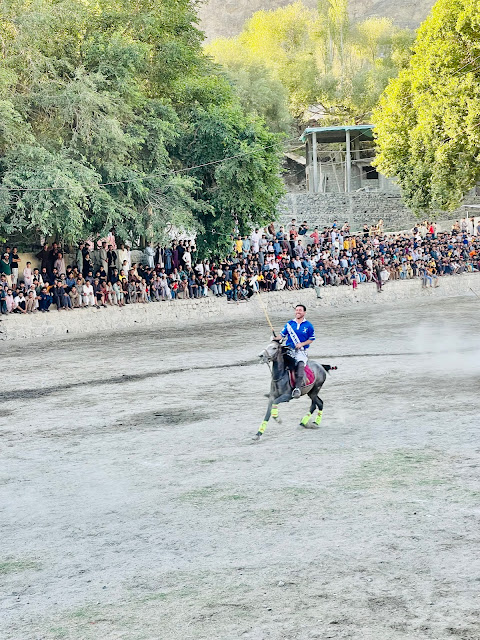Baltistan, also known as Little Tibet, is a region located in the Gilgit-Baltistan territory of northern Pakistan. Polo is a popular sport in this region, with a long history and a strong tradition. The locals have a deep passion for the game, and polo matches are frequently held in Baltistan.
A polo match in Baltistan is a thrilling experience for both players and spectators. The matches are usually held in open fields, with breathtaking mountain backdrops adding to the scenic beauty of the event. The local community gathers to witness the intense competition and cheer for their favorite teams.
The game of polo in Baltistan is unique in its own way. The locals have developed their own style and rules, which differ slightly from the traditional polo played in other parts of the world. Balti polo, as it is called, involves teams of six players each, rather than the usual four. The horses used for playing are known as "ponies," which are smaller in size but incredibly agile and well-trained.
The polo match in Baltistan is not just about the game; it is a celebration of local culture and traditions. Spectators can enjoy traditional music and dance performances during halftime, adding to the festive atmosphere. Local artisans also set up stalls to showcase their handicrafts, allowing visitors to explore and purchase unique souvenirs.
Attending a polo match in Baltistan provides an opportunity to witness the skill and athleticism of the players, as well as immerse oneself in the rich cultural heritage of the region. It is an experience that combines the excitement of the sport with the beauty of the surrounding landscape and the warmth of the local community.
Polo has a significant importance in the history of Baltistan. The region of Baltistan, located in the Gilgit-Baltistan region of Pakistan, has a rich cultural heritage that includes the sport of polo.
Polo is believed to have originated in Central Asia and spread to different parts of the world, including Baltistan. The sport gained popularity in the region due to its association with the Balti royal families. The Balti rulers, known as Rajas, actively patronized polo and organized matches as a source of entertainment and to showcase their power and influence.
Historically, polo matches in Baltistan were not just a sport but also a way to resolve disputes and conflicts between different communities. The matches were often organized as friendly competitions between different regions or villages, serving as a platform for people to come together, socialize, and build relationships.
The polo matches in Baltistan were also instrumental in fostering a sense of unity and identity among the Balti people. It provided them with a common platform to celebrate their culture and heritage. These matches were not only attended by the local population but also attracted spectators from neighboring regions, adding to the festive atmosphere.
Furthermore, polo in Baltistan has a unique style that distinguishes it from other forms of the game. The Balti style of polo, known as "Balti Loshor," is played with fewer rules and regulations compared to international polo. It is characterized by its fast-paced and aggressive nature, with players often displaying exceptional horsemanship skills.
Today, polo remains an integral part of Baltistan's cultural fabric. The region hosts various polo tournaments and festivals, attracting both local and international participants and spectators. These events not only promote the sport but also contribute to the local economy and tourism industry.
In conclusion, the polo matches in Baltistan hold great historical and cultural significance. They have played a crucial role in shaping the region's identity, resolving conflicts, and promoting unity among the Balti people. The sport continues to thrive in Baltistan, serving as a testament to the region's rich heritage and traditions.
The history of polo games in Gilgit-Baltistan can be traced back to ancient times. The region has a rich cultural heritage and has been a crossroads for various civilizations throughout history. The origins of polo in Gilgit-Baltistan are believed to date back to the time of the Persian Empire.
Polo, known as "Chogan" in the local language, was introduced to the region by the Persian Emperor Darius I during the 6th century BC. The Persians were known for their love of equestrian sports, and polo was one of their favorite pastimes. It is said that Darius I brought the game to the region as part of his efforts to expand his empire.
Over time, polo became popular among the local population of Gilgit-Baltistan. The rugged terrain and the abundance of horses in the region made it an ideal place for the sport to flourish. Polo matches were not only a form of entertainment but also served as a way to train warriors for battle.
During the medieval period, the region came under the influence of various Central Asian and Mongol empires. Polo continued to be played and further developed during this time. The game became an integral part of the cultural fabric of Gilgit-Baltistan, with various rulers and nobles patronizing the sport.
The British, who colonized the Indian subcontinent in the 19th century, also played a significant role in the development of polo in Gilgit-Baltistan. The British army introduced polo to the region as a means of recreation and training for their soldiers. The sport gained popularity among the local population as well, and polo clubs were established in various towns and villages.
Today, polo remains a popular sport in Gilgit-Baltistan, with several tournaments and matches held throughout the year. The region has produced many skilled polo players who have represented Pakistan at national and international levels. Polo has become an important cultural symbol of Gilgit-Baltistan and continues to be cherished by the local community.












0 Comments